Gingee
Senji is a panchayat town in Villupuram district (erstwhile South Arcot district) in the Indian state of Tamil Nadu. The nearest towns with railway stations are Tindivanam, 28 km away, and Thiruvannamalai, 29 km away. Senji is located between three hills covering a perimeter of 3 km.
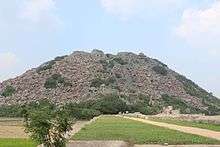
Senji | |
|---|---|
Town Panchayat | |
 View of Senji fort | |
 Senji Location in Tamil Nadu, India | |
| Coordinates: 12.15°N 79.30°E | |
| Country | |
| State | Tamil Nadu |
| District | Villupuram district |
| Government | |
| • Type | Tamil Nadu |
| Elevation | 92 m (302 ft) |
| Population (2011 census) | |
| • Total | 27,045 |
| Languages | |
| • Official | Tamil |
| Time zone | UTC+5:30 (IST) |
| Vehicle registration | TN-16 |
Senji is famous for its Senji Fort, a popular tourist attraction. The Kon dynasty laid the foundations for the Senji Fort in 1190 AD.[1] The fort was later built by the Chola dynasty in the 13th century. In 1638, Senji came under the control of Bijapur Sultanate from Vijayanagar. In 1677, it was under the control of Maratha king Shivaji. In 1690, it came under the Mughals, when it became the headquarters of Arcot. It changed hands to the French in 1750, and then to the British in 1762. During this time, many sculptural aspects of Senji were shifted to Pondicherry by the French.
To visit Senji fort, guides are available from archaeological office which is on the way to the fort. The office is open for visitors from 9:00 to 17:00 (9am to 5pm). The fee for visitors and tourists for visiting the fort is Rs.10.
History
The founding of the Kon dynasty provides the launching of Senji as a fortified royal center.[2] The Senji country then came under the rule of the Hoysalas in the later part of the 13th and in the first half of the 14th century. From the Hoysalas it passed on, by relatively easy efforts, into the hands of the first rulers of Vijayanagara empire. The Vijayanagar dominion gradually expanded over South India and divided the administration into three important provinces, which were under the control of Nayaks. These were the Nayaks of Madurai, Nayaks of Tanjore and Nayaks of Senji. Information about the Gingee Senji and their rule is very scanty. It is said that Tupakula Krishnappa Nayaka (1490 to 1521) of a Chandragiri family was the founder of the Nayaka line of Senji kings.[3][4][5][6][7][8] He seems to have ruled gloriously all over the coast from Nellore down to the Coleroon up to 1521 AD. Under the Nayaks the forts were strengthened and the town was greatly enlarged.
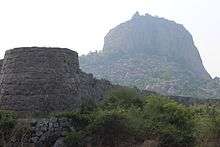
The last Nayak of Senji was forced to surrender to the Bijapur army towards the end of December 1649 AD. The booty acquired by the Mohammedan rulers of Bijapur was 20 crores of rupees in cash and jewels. Senji assumed a new and enhanced strategic importance under the Bijapur governors. Bijapur was in possession of the fortress of Senji till 1677 AD, when Chatrapati Shivaji, the son of Shahaji fell upon it in his Carnatic expedition. The Marathas greatly strengthened and fortified its defences.
The Mughals were then able to capture the fort of Senji in the Carnatic from Rajaram the King of the Marathas, early in 1698, after a siege of seven years. Zulfikar Khan, the son of Asad Khan, the Grand Vizir in the court of Aurangazeb, was in command of the siege operation of Senji and of its governor till he left the Carnatic after about a year from its fall.
After that Aurangazeb, granted a mansab of 2,500 rank and jagir of 12 lakhs to Raja Swarup Singh, a Bundela Rajput chieftain, along with the killedari (Fort Commandership) of Senji in 1700 AD. Raja Swarup Singh died of old age in 1714 AD. His arrears of payments due to the faujdari amounted to 70 lakhs, being a defaulter for ten years. The Nawab of Arcot reported this matter to the Badshah (Mughal Emperor) at Delhi. Hearing about the death of his father, Desingh, the son of Raja Swarup Singh, started for Senji from Bundelkhand, his ancestral home.
On arriving at Senji, Desingh assumed the government of Senji after performing the last rites of his father. Aurangazeb had granted a firman to his father and Desingh took formal possession of his father's jaghir on ground of his hereditary right. Desingh did not receive a warm welcome from the Mughal officers. The Nawab of Arcot, Sadatullah Khan, who attempted to dispossess Desingh, pleaded that the firman was not valid. When Payya Ramakrishna, who was his secretary, informed him of the legal necessity of getting the firman renewed by the new Emperor before assuming the jaghir, Desingh replied that he had got the firman of Aurangazeb and that he need not apply to anybody else.
In fact after regaining the fort from Marathas, Aurangzeb had first appointed Nawab Daud Khan as the deputy subahdar of the Deccan. Nawab Daud Khan removed his headquarters from Senji to the town of Arcot, as he believed that the place was not healthy. This diminished the importance of Senji. While shifting his headquarters, Daud Khan appointed Sadatullah Khan as his Diwan and Faujdar in 1708. Sadatullah Khan later became the Nawab of the two Carnatics in 1713, under Nizam-Ul-Mulk. He was the regular and acknowledged Nawab of the Carnatic between the years 1710 and 1732 AD. After the death of Raja Swarup Singh he renewed the demand for the arrears of revenue with his son Raja Desingh. This led to a battle between the two, which unfortunately ended in the death of the young and valiant Rajput, Desingh on 3 October 1714. He struggled at the young age of 22, against the powerful Nawab Sadatulla Khan of Arcot in a struggle that was hopeless from the outset (Desingh's army consisted of only 350 horses and 500 troopers, while the Nawab's army had 8,000 horsemen and 10,000 sepoys). The ballets are sung in and around Senji till date about his bravery. However, the fortress of Senji lost its pre-eminent position and political importance within a few years of the extinction of the Rajput rule.
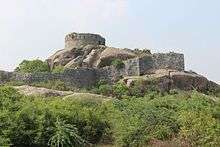
Subsequently, the two European rival powers in India, the English and the French, got themselves involved in the internal quarrels and fights and the French won for themselves the Senji fortress on the 11th Sept., 1750, under the initiative of Bussy. They took good care to secure the fort by a strong garrison, which was well supported with artillery and ammunition.
Senji remained firmly in French possession until after the fall of Pondichéry to Sir Eyre Coote in January 1761. The English commander was Captain Stephen Smith. With the fall of Senji the French lost their last possession in the Carnatic.
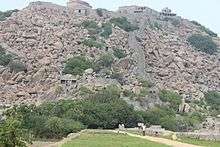
Senji regained its political importance, for the last time in its fateful history, in 1780 AD, when Haidar Ali, helped by some able French Officers, invaded Carnatic with a force of 90,000 men. Haidar's men appeared before the fortress and easily carried it by their assault in November 1780. The English re-conquered it at the close of the second Mysore war from Tippu Sultan in 1799. After that Senji had been free from the ravages and anarchy of war, but subject to desolation and decay. During the frequent Indo-French Wars, the British resident wanted the Fort and The Fortification to be demolished. Luckily his suggestion was not accepted and the Fort remains for us to experience and relive the history. The presence of Muslim rulers in Senji is evident from the inhabitants of a nearby village called Minambur, where the Urdu speaking Navaitha Muslims living with their unique culture and tribes such as Shakir, Koken, Bhanday Bhonday, Choudary, Pappa, Aghalay, Hazari, Amberkhani, Sayeed etc.
Geography
Senji is located at 12.25°N 79.42°E.[9] It has an average elevation of 92 metres (301 ft). Senji is 147 km from Chennai and 64 km from Puducherry (Pondy).
Demographics
| Year | Pop. | ±% |
|---|---|---|
| 1951 | 7,941 | — |
| 1961 | 8,765 | +10.4% |
| 1971 | 10,222 | +16.6% |
| 1981 | 15,106 | +47.8% |
| 1991 | 16,990 | +12.5% |
| 2001 | 21,251 | +25.1% |
| 2011 | 27,045 | +27.3% |
| Source: | ||
According to the 2011 census, Senji had a population of 27,045 with a sex-ratio of 975 females for every 1,000 males, much above the national average of 929.[12] A total of 2,893 were under the age of six, constituting 1,470 males and 1,423 females. Scheduled Castes and Scheduled Tribes accounted for 19.8% and 1.12% of the population respectively. The average literacy of the town was 76.4%, compared to the national average of 72.99%.[12] The town had a total of 6,259 households. There were a total of 10.936 workers, comprising 487 cultivators, 640 main agricultural labourers, 414 in house hold industries, 5,721 other workers, 3,664 marginal workers, 45 marginal cultivators, 1,867 marginal agricultural labourers, 330 marginal workers in household industries and 1,442 other marginal workers.[11]
Religious Places
Shiva temple, situated below the fort, was built in the period of Desingu Raja who was the king of Senji Fort
Ranganathar temple is situated on a small hill in Singavaram Village very near to Senji Fort.[13]
Pasumalai Murugan temple in mel olakkur village is also situated near to Senji town.
Mel Sithamur Jain Math is a Jain Matha that is near Senji.[14]
It is the primary religious center of the Tamil Jain community.[15] It is headed by the primary religious head of this community, Bhattaraka Laxmisena Swami.[16]
The Villupuram area has been an important centre of Jainism since ancient times.[17] Historically, there was a Jain Math at Kanchipuram but it was shifted to its current location here.[18]
Politics
Senji assembly constituency is part of Arni (Lok Sabha constituency). Senji itself a legislative constituency which is currently held by the DMK party and K.S.Masthan is currently the Member of the Legislative Assembly for Senji.
Gallery
| Wikimedia Commons has media related to Gingee. |
 Gingee Fort, Krishnagiri
Gingee Fort, Krishnagiri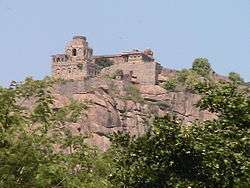 Gingee Fort, Rajagiri Hill
Gingee Fort, Rajagiri Hill- Gingee Fort View
 Gingee Jain temple
Gingee Jain temple- Residence of Bhattaraka Laxmisena at the Mel Sithamur Jain Math
Notes
- Alf Hilteibetel. The Cult of Draupadi. University of Chicago.
- Alf Hilteibetel. The Cult of Draupadi. University of Chicago.
- Velcheru Narayana Rao, David Shulman. Classical Telugu poetry: an anthology, Page 63.
- Sanjay Subrahmanyam. Penumbral visions: making polities in early modern South India, page 198.
- BS Baliga. Tamil Nadu district gazetteers, page 427.
- Delhi School of Economics. The Indian economic and social history review?, page 411 mentions: "... this time run by Balija and other Naidu families, and involving such personages in the 1630s and 1640s as Tubaki Krishnappa Nayaka of the Senji family, ..."
- Sanjay Subrahmanyam. The Political Economy of Commerce: Southern India 1500-1650, page 304 mentions: "Achyutappa, it is generally believed, belonged to the Balija Chetti mercantile community, originally of Telugu extraction, but settled in the Tamil region as a part of the extensive migratory movement from the Andhra to the Tamil regions that began c.1350 and continued into our period."
- Sanjay Subrahmanyam. Improvising empire: Portuguese trade and settlement in the Bay of Bengal, 1500–1700, page 206 mentions: "..perhaps as early as 1608, the VOC's factors had maintained close contact with a family of Achyutappa and his brother Chinnanna, but also two nephews, Koneri and Sesadra."
- Falling Rain Genomics, Inc - Gingee
- Urban Infrastructure Report 2008, p. 9
- "Census Info 2011 Final population totals - Gingee". Office of The Registrar General and Census Commissioner, Ministry of Home Affairs, Government of India. 2013. Retrieved 26 January 2014.
- "Census Info 2011 Final population totals". Office of The Registrar General and Census Commissioner, Ministry of Home Affairs, Government of India. 2013. Retrieved 26 January 2014.
- "Sri Singavaram Perumal temple".
- "News Updates". Www.Jainheritagecentres.Com. 11 December 2009. Archived from the original on 18 June 2013. Retrieved 27 May 2012.
- "Tourist Information of Vilupuram District Tamilnadu South Indian States India". Southindianstates.com. Archived from the original on 21 June 2013. Retrieved 27 May 2012.
- Facets of Jainology: Selected Research Papers on Jain Society, Religion, and ... - Vilas Adinath Sangave - Google Books. Books.google.com. Retrieved 27 May 2012.
- "Front Page : Mahavira bas-relief tells a story". The Hindu. 8 August 2008. Retrieved 27 May 2012.
- "on www.jainsamaj.org ( Jainism, Ahimsa News, Religion, Non-Violence, Culture, Vegetarianism, Meditation, India. )". Jainsamaj.org. Retrieved 27 May 2012.
References
- Questioning Ramayanas - by Paula Richman
- The Literary Cultures in History - by Sheldon I Pollock
- Further Sources of Vijayanagara History By K A Nilakanta Sastry
- Penumbral Visions - by Sanjay Subrahmanyam
- Conversion of City Corporate Plan to Business Plan for Pudukkottai municipality (PDF) (Report). Commissioner of Municipal Administration, Government of Tamil Nadu. 2008. Retrieved 9 May 2015.
External links
| Wikimedia Commons has media related to Gingee. |